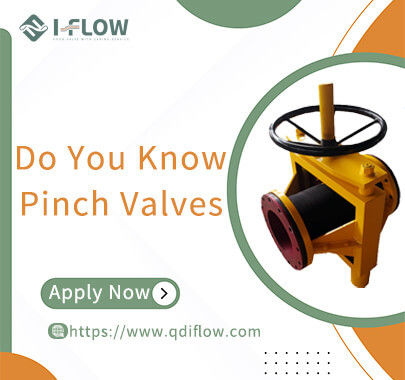

Tel: +86-532-66952179/66952180
Fax: +86-532-66952181
E-mail:info@qdiflow.com
Sales office address: Unit 1517-1520, Building 4, Excellence Century Center, No. 31 Longcheng Road Qingdao, China.
Factory address: No.15, Jinshajiang Road, Tongji Street, Jimo District, Qingdao,China

What Is a Pinch Valve
At its core, a pinch valve consists of a flexible elastomer sleeve housed within a rigid body. As pressure is applied to the sleeve—either pneumatically or manually—the sleeve compresses, pinching closed against the valve body and halting flow. Releasing that pressure allows the sleeve to rebound, restoring an unobstructed flow path. Because the fluid contacts only the inner surface of the sleeve, corrosion and contamination risks are dramatically reduced.
How Pinch Valves Work
Pressure Application
Pneumatic or hydraulic force compresses the elastomer sleeve uniformly.Sealing Action
The sleeve collapses inward, creating a tight shut-off by conforming to the valve’s interior.Flow Restoration
Once the actuating pressure is relieved, the sleeve’s elasticity returns it to its original shape, reopening the line.
This straightforward mechanism delivers quick response times and positive shut-offs, even when handling solids-laden or abrasive fluids.
Key Benefits of Pinch Valves
Zero Contamination
Fluids contact only the elastomer, eliminating crevices where residue can accumulate—ideal for food, beverage, and biopharmaceutical processes.Exceptional Abrasion Resistance
A durable sleeve withstands slurries, powders, and particulate matter without degrading the valve body.Bi-Directional Sealing
The sleeve’s uniform compression blocks flow from either direction, providing reliable backflow prevention.Minimal Maintenance
Fewer moving parts mean less wear. When the sleeve eventually needs replacement, it’s a quick swap-out—avoiding full valve body removal.Versatile Actuation
Handwheels, pneumatic actuators, or electric motors can pinch the sleeve, adapting to varied automation levels.
Limitations to Consider
Pressure Constraints
While pinch valves handle moderate pressures well, extreme pressure or vacuum conditions can exceed elastomer limits.Temperature Range
Elastomer sleeves have defined operating temperatures; high-heat applications may require specialized materials.Flow Control Precision
Fine throttling is possible, but control accuracy falls short of globe or control valves in critical process loops.
Common Pinch Valve Types
Manual Pinch Valves
Hand-operated levers or handwheels compress the sleeve; perfect for simple on/off control in small systems.Pneumatic Pinch Valves
Air-powered actuators enable rapid, remote operation; widely used in wastewater treatment and mining.Electric Pinch Valves
Motorized actuation offers precise automation integration, suitable for process industries requiring centralized control.
Common Problems When Using Pinch Valves
Sleeve Wear and Tear
Frequent cycling against abrasive media can cause the elastomer sleeve to degrade prematurely, leading to leaks or loss of seal integrity.Chemical Incompatibility
Some aggressive chemicals can attack certain elastomer materials, causing swelling, softening, or cracking of the sleeve.Actuator Malfunction
Pneumatic or electric actuators may fail due to moisture, dust ingress, or electrical faults, preventing proper sleeve compression.Incorrect Sizing
Undersized sleeves can over-compress and fatigue quickly, while oversized sleeves may not fully close the flow path, causing drips or incomplete shut-off.Temperature Extremes
Operating beyond the sleeve’s rated temperature range can cause stiffness (in cold environments) or excessive softening (in high heat), both of which impair valve performance.Pressure Surges
Sudden spikes in upstream pressure can momentarily unseat the sleeve or damage the body, leading to uncontrolled flow or sleeve blow-out.
Selecting the Right Pinch Valve
Fluid Characteristics
Compatibility with the elastomer sleeve—consider chemical resistance, pH range, and solids content.Operating Pressure & Temperature
Verify that both the elastomer and valve body can withstand process conditions without sleeve deformation or damage.Flow Requirements
Larger diameters ease flow of viscous slurries; confirm that the valve’s Cv rating meets your process demand.Automation Needs
Ensure actuator compatibility—pneumatic or electric—to align with your control architecture.
Applications Across Industries
Wastewater Treatment
Managing sludge and grit without valve body wear or clogging.Mining and Minerals Processing
Regulating abrasive slurries containing sands, tailings, or ores.Food & Beverage
Guaranteeing sanitary conditions in wort transfer, juice processing, or dairy lines.Chemical Processing
Handling corrosive, viscous, or particulate-filled fluids with minimal contamination risk.Pharmaceutical & Biotech
Maintaining sterile, particle-free flow for culture media and sensitive solutions.